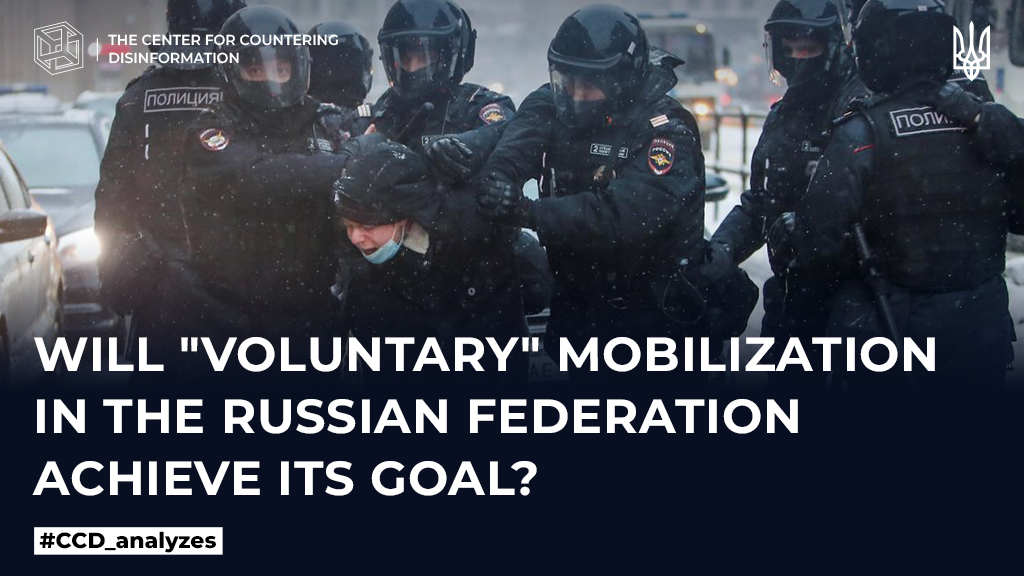Rumors about the beginning of a new wave of mobilization in russian society have appeared since the end of 2022, despite the fact that the kremlin continues to deny such plans.
❗️putin announced a partial mobilization in russia on September 21, 2022, when the russian federation suffered heavy losses in the Kharkiv region. At that time, up to 330,000 reservists were recruited into the ranks of the USSR. The state duma of the russian federation allowed to send parents with many children to war, criminals convicted of serious crimes, and to carry out mobilization in the occupied Ukrainian territories. russian minister of defense shoigu stated that 82,000 mobilized russians were sent to Ukraine (up to 150,000 according to independent data), many of whom have already died or been injured (recently 700-1,000 per day).
The shortage of “cannon fodder” for the war in Ukraine has become so noticeable that mobilization is again on the agenda of the kremlin. However, the burning of military commissariats, protests by local mobilized people (law enforcement officers detained 1,320 people in 39 cities), the mass flight of young people from mobilization abroad (up to 1 million people) caused such a rapid drop in the ratings of the russian government and putin personally that a new official mobilization could lead to mass riots and violent regime change. Therefore, the kremlin decided, against the background of refutations of the announcement of a new “wave” of mobilization, to actually continue it in a hidden mode. So, shoigu plans to start a new recruitment for the contract army from April 1. Its initiator is called the deputy chairman of the security council of the russian federation d.medvedev, who wants to find another 400,000 units of “cannon fodder”.
To avoid the unpopular term “mobilization”, kremlin propaganda everywhere replaces it with “voluntary-forced recruitment of military personnel.” Under the slogans of the mobilization “volunteer” campaign, the ministry of defense sent documents to the regional military commissariats indicating the number of contractors, while the governors will be responsible for the implementation of the plan. In particular, it is planned to recruit 10,000 people each in the chelyabinsk and sverdlovsk regions, and 9,000 contract workers in the perm region.
And so that potential conscripts do not start fleeing again, from January 9, all categories of conscripts, even those with limited fitness for service, were prohibited from going abroad. As after the announced “partial mobilization” in September of last year, residents of 42 regions of the russian federation (including moscow, st. petersburg, belgorod and murmansk regions, altai, perm, krasnoyarsk, krasnodar regions) began to actively send summonses. Groups of military commissar employees arrive at enterprises and institutions to conduct agitational activities among employees, which are accompanied by moral pressure and intimidation. The military commissariat will pay special attention to graduate students, some of whom are already receiving subpoenas allegedly to clarify data. For example, graduates of the moscow Aviation Institute are refused diplomas until they sign the summons.
To soften the expected negative reaction of the population, a draft law on raising the conscription age with a transitional period until 2026 has been submitted to the russian state duma. They want to raise the maximum conscription age from 27 to 30 immediately, and the minimum from 18 to 21, with an annual increase of one year between 2024 and 2026. The outwardly attractive decision of the authorities to protect a new generation of russians from the demographic and social consequences of the war against Ukraine actually gives the authorities the opportunity to conscript even more russians of the same age group (from 27 to 30 years old) into the army over the next three years.
An attempt to distribute the negative consequences of the war (deaths, injuries) among one group of russians will invariably lead to the stratification of russian society. The reduction of the conscription age may also indicate that the kremlin does not expect the war in Ukraine to last longer than the next three years.
At the same time, as senior officials of the mobilization system of the russian federation admit, the new draft will face the same problems as the previous one. Namely: the lack of an adequate number of sets of uniforms, modern weapons, protective helmets and body armor. Taking recruits to belarus for special training shows the lack of their own military instructors, and the predominant formation of rifle units, instead of motorized rifle and tank units, shows the lack of combat equipment.
❗️So, despite putin’s refusal to announce a new draft, mobilization measures are only increasing in a hidden mode. Plans to strengthen the combat capability of the army and correct the situation at the front at the expense of 400,000 “volunteers” remain questionable. However, the enemy cannot be underestimated, because part of the mobilized from the first wave, who have gained combat experience, remain in the “formation”.










